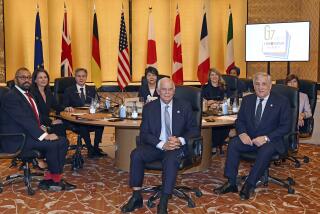7-Nation Council Skirts Action on Dollar’s Slide : Finance Officials Affirm the Paris Agreement but Add No New Teeth to Halt Decline Against Yen
WASHINGTON — Top finance officials of the leading industrial democracies made little effort Wednesday to challenge the recent decline of the dollar against the Japanese yen.
While the officials affirmed their 7-week-old currency agreement aimed at braking the two-year slide of the dollar against most major currencies, they fell short of adding any new teeth to the accord they reached in Paris during February.
Currency traders are likely to make new efforts to test the limits of that agreement, and many analysts remain skeptical that government intervention can make the accord stick until there are solid indications that the U.S. trade deficit is beginning to shrink substantially.
The first indication of market reaction came from early trading today in Tokyo, where the dollar quickly lost more than half a Japanese yen and half a West German pfennig. Japan’s central bank stepped in by buying a modest amount of dollars.
Early Currency Trading
After about an hour of trading in Tokyo, the dollar had stabilized just above 145 yen and 1.82 marks. It had closed Wednesday in New York at 146 yen and 1.83 marks. Despite the dollar’s initial weakness, some brokers in Tokyo were encouraged by its ability to hold at the level of 145 yen.
In the statement issued by the so-called Group of Seven after the meeting, the officials from the United States, West Germany, Japan, Great Britain, France, Canada and Italy agreed “that further actions will be essential to resist rising protectionist pressures, sustain global economic expansion and reduce trade imbalances.” But they did little more than agree once again that their “currencies are within ranges broadly consistent with economic fundamentals.”
“Is that it?” asked one skeptical trader at a Wall Street securities company. “I was expecting something more than that.”
Guarded in Statements
Japanese Finance Minister Kiichi Miyazawa, meeting with reporters after the four-hour conference, was careful to avoid condemning the further decline of the dollar against the yen since the Feb. 22 Paris agreement.
Miyazawa, in his press conference, declined repeatedly to question whether the recent strengthening of the yen was unacceptable to the Japanese. “What has happened in the last several weeks should not be taken as something extraordinary or requiring review of the Paris agreement itself,” he said.
The fall in the U.S. currency from about 153 yen per dollar at the time of the Paris agreement to the current level “is not outside the range of agreement or discussion,” Miyazawa said.
Although both the Federal Reserve and the Japanese central bank have intervened in currency markets over the past several weeks to cushion the decline, Miyazawa’s statement appeared to undercut market expectations that the finance ministers would oppose any decline of the dollar below 150 yen.
After a period of relative calm in financial markets in the wake of the Paris accord, the dollar has recently fallen to record lows against the Japanese yen as trade tensions between the two nations have escalated.
In trading before the announcement Wednesday evening, the dollar closed higher against most currencies but was well off the day’s peaks.
“The markets are taking a wait-and-see attitude,” said Mickey Levy, chief economist at Fidelity Bank in Philadelphia. “It’s more like a footrace to see whether the trade figures will improve quickly enough to stabilize the dollar. I’m very skeptical about the ability of these meetings to influence the markets for long.”
For more than a year, ever since monetary officials agreed at New York’s Plaza Hotel in September, 1985, to encourage the dollar’s decline, the Reagan Administration has welcomed the fall because it wants to reduce the giant U.S. trade deficit.
Although the trade gap has shown only modest signs of narrowing so far, the cheaper dollar--by working to boost the price of imports and make exports less expensive abroad--is expected to begin helping U.S. manufacturers substantially this year.
But starting last October, when Treasury Secretary James A. Baker III and Japan’s Miyazawa agreed to try to stabilize the dollar against the yen, U.S. officials began warning of the dangers of a plunge in the dollar.
Federal Reserve Chairman Paul A. Volcker, worried about the possibilities of higher inflation due to rising import prices, has repeatedly emphasized the importance of preventing a free fall in the dollar.
U.S. officials are worried that any further decline in the dollar could backfire by weakening growth in Japan and Germany so badly that they will be forced to cut back on buying imports from abroad. That, in turn, would hamper U.S. efforts to narrow the trade deficit.
In an effort to stem any further fall in the dollar, the finance officials focused on the recent Japanese proposals to stimulate their own domestic economy. For months, the U.S. government has been trying to prod both Japan and West Germany into spurring economic growth at home in order to absorb a greater share of the world’s exports.
The joint statement Wednesday suggested that finance officials believe Japan’s $34.5-billion economic stimulus package offers the best hope of stemming the dollar’s further decline against the yen.
And Miyazawa signaled that his country’s leaders feel they now have done enough to mollify the other industrial powers.
More to Read
Sign up for Essential California
The most important California stories and recommendations in your inbox every morning.
You may occasionally receive promotional content from the Los Angeles Times.










